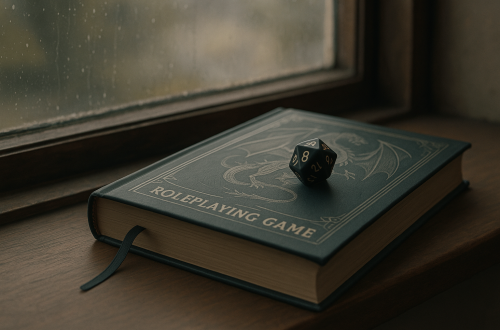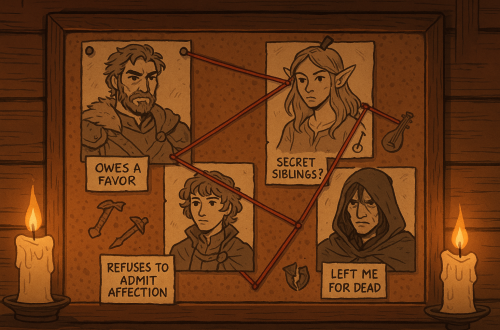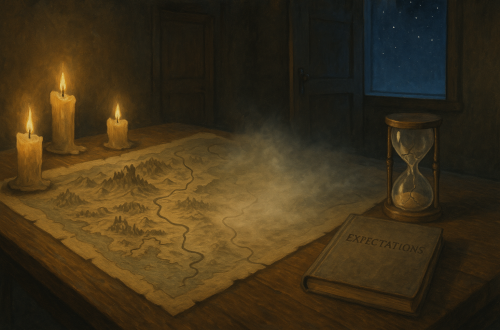Embracing Collaborative Narrative in Tabletop Gaming
Imagine this: you’ve spent two weeks crafting the perfect session. You have dungeon maps, NPC motivations, even some subtle foreshadowing and some dramatic lines for the big boss. Now, on game day, your players roll up to the door of the dungeon, take one look at your ominous stone doorway, and decide, “let’s go talk to that farmer we met three sessions ago instead”.
We’ve all been there. You spent so much time and energy, and now your carefully orchestrated plans are closely resembling a collapsing house of cards. Your first instinct is probably to nudge (or violently shove) your players back towards your prepared content. And you can do that, that’s your prerogative, but you should know your players would have more fun if you let them go find this farmer. But what if I told you that you might have more fun, too?
Mindset Shift: from Writer to Improv Partner
A really common mindset for GMs is to assume that our job is to be a storyteller, and our players are the characters in our story. We craft elaborate plots and dramatic beats, and we carefully leave breadcrumbs we expect our players to follow. But TTRPGs aren’t novels or movies, they’re collaborative storytelling (yes, I do say that all the time, and no, I will not stop). Your players aren’t here to read a book, they’re here because they want creative agency. They want to create WITH you, not just act out your story.
I propose this mindset shift: think of yourself less as a railroad conductor keeping everyone on track, and more as an improv partner responding to what your players are bringing to the scene. When players make unexpected choices, they’re not breaking your story, they’re telling you what parts of the world they want to engage with! They’re showing you where their investment lies.
Player investment comes from meaningful choices, not from experiencing your predetermined narrative. When players feel like their decisions matter and can genuinely change the direction of the story, they become more engaged, more creative, and more emotionally invested in the outcomes.
Practical Techniques for Following Player Lead
The Yes, and… Principle
Borrowing from (or shamelessly ripping off of) improv comedy, “yes, and…” is the secret weapon for embracing player agency. No, you don’t have to literally say “yes, and…”, it’s more of a mentality than a line of dialogue. When a player suggests something unexpected, your default response should be to accept their idea and build on it, rather than shutting it down.
Player: “I want to investigate that merchant we met last session. Something seemed off about him.” Instead of: “No, they’re not important. Let’s focus on the main quest.” Try: “Now that you mention it, you do remember they had some unusual scars on their hands…”
If you’re having a brain fog moment, you can ask the player for more information to help prompt you to come up with what happens next. Maybe ask “what seemed off about him?” or “what suspicions do you have about him?” The answers your players give can inspire you to create something surprising. Once you know what they think, you are free to decide if they are right or wrong!
Building Bridges, Not Walls
When players go in an unexpected direction, look for ways to connect their new path to your existing plot threads. That random merchant they’re suddenly interested in might be secretly connected to the villain’s organization, or the detour to visit the farmer might lead to more information about strange happenings that tie into your main story.
The Three Clue Rule
Always have at least three different ways for players to discover vital information, but crucially: keep these flexible. What I mean is: don’t plan for Martha the Apothecary to tell the players that all the plants are dying, play for “an NPC” to tell the players that all the plants are dying. If your players don’t run into Martha the Apothecary, they will still get the information they need to leap into your story. If they skip your planned exposition dump with the wise sage, maybe they find the same information in some ancient books, overheard conversations, or cryptic dreams. This flexibility keeps your story moving forward regardless of which path your players choose.
When Players Go Completely Off-Script
Sometimes players don’t just take a detour, they abandon the highway entirely and race off into uncharted territory. Don’t panic. Here’s how to handle those moments:
Listen to Them
If you have multiple players, chances are they need to have a discussion before they all hijack the story and do something else. If you listen to that conversation, they will tell you what they are hoping for. They might be tired of the desert theme you have in this setting and are hoping to get somewhere greener, they might be spontaneously interested in finding one character’s brother, they might have thought you were dropping a hint several weeks ago when one door creaked and another one didn’t. Follow these leads and use your creativity to fill in the gaps.
Take a Break
If your players just took your whole adventure idea out back and shot it, it’s okay to call for a short break. Tell your players you need to grab some water or use the restroom, then take a few minutes to regroup mentally. Think about what the players are really trying to accomplish and how you can make it interesting.
Recycle and Repurpose
The dungeon your players just refused to enter doesn’t have to go to waste. Maybe it becomes a hideout for a different group of enemies, or the location of a future confrontation. Those NPCs you prepared can show up in the new location your players have chosen to explore. Don’t panic and think all your work has gone to waste. You can probably still use it, it just might not look exactly like you planned it.
Embrace the Chaos
Sometimes the best stories come from completely unexpected places. If your players want to go on a side quest to help a goblin find their missing cat, let them. It might become the most memorable part of your whole campaign. Trust in the collaborative process and see where it leads.
Overcoming Your Fears
I’m not psychic, so I can’t assuage all of your fears (but if you have a specific concern, let me know!) I can tell you what my fears were, though, and how to get over those.
The Sunk Cost Fallacy
Your prep isn’t wasted, it’s just postponed. That dungeon can appear later, in a different context or with different stakes. Plus, the time you spent creating it helped you understand your world better, even if players never see every room. It’s hard not to feel committed when you did all this work, and disappointed that it feels like it won’t be used. It’s okay to feel that way, but remember that your players are here to play too, and your feelings aren’t necessarily the most important consideration.
On the flip side of this situation: not only does it feel like your preparation is wasted, but now you’re starting down the barrel of a session for which you are completely unprepared. For instance, the farmer your players want to visit? You have no idea what their house looks like, what their personality is, or what they might know. The anxiety of having to improvise everything on the spot can be paralyzing.
This fear is completely valid, and every GM has felt it. I know I am making the argument in this post to take your sessions off the rails, but you’re probably a human, and humans need to feel prepared. This is a job for the GM Toolbox, your kit of tools to fill in gaps when you can’t come up with everything on the spot. If you don’t already have a Toolbox, you should check out my other posts to see how to make one.
Keep in mind that your players aren’t expecting perfection, they’re expecting engagement. A simple, improvised NPC who responds genuinely to the players’ questions will be more memorable than the most elaborately planned encounter.
Narrative Coherence Concerns
Stories don’t have to be perfectly linear to be satisfying. Real life is messy and nonlinear, and great adventures mirror that chaos. As long as character motivations remain consistent and consequences feel meaningful, players will find the through-lines.
Maintaining Dramatic Tension
Tension comes from meaningful stakes and uncertainty, not from following a predetermined path. If anything, improvised moments can create more tension because even you don’t know how they’ll resolve.
Building Confidence Through Practice
Start small. Let players take the lead on minor side quests or social encounters. As you get more comfortable with improvisation, gradually expand your comfort zone. Remember, every experienced GM was once a noob. I also prescribe reading fiction and watching television, as those can turn into sparks of inspiration at just the right moment.
Collaborative Storytelling Requires Collaboration
The unique magic of TTRPGs lies in their collaborative nature. No other medium allows for the kind of real-time creative partnership that happens around a gaming table. When you follow your players’ lead, you’re not losing control of the story, you’re sharing creative authority with people who are just as invested in creating something amazing as you are.
The best stories come from the unexpected moments, the improvised solutions, and the collaborative “what if” conversations that happen when everyone at the table is contributing to the narrative. Your job as a GM isn’t to force players through your prearranged adventure, it’s to help them explore the story they’re most excited to experience.
So next time your players completely and totally derail your meticulously planned session, take a deep breath and remember: you’re not the boss, you’re the GM. Trust yourself, trust your players, and trust in the collaborative process. The story you create together will be better than anything could have planned alone.



